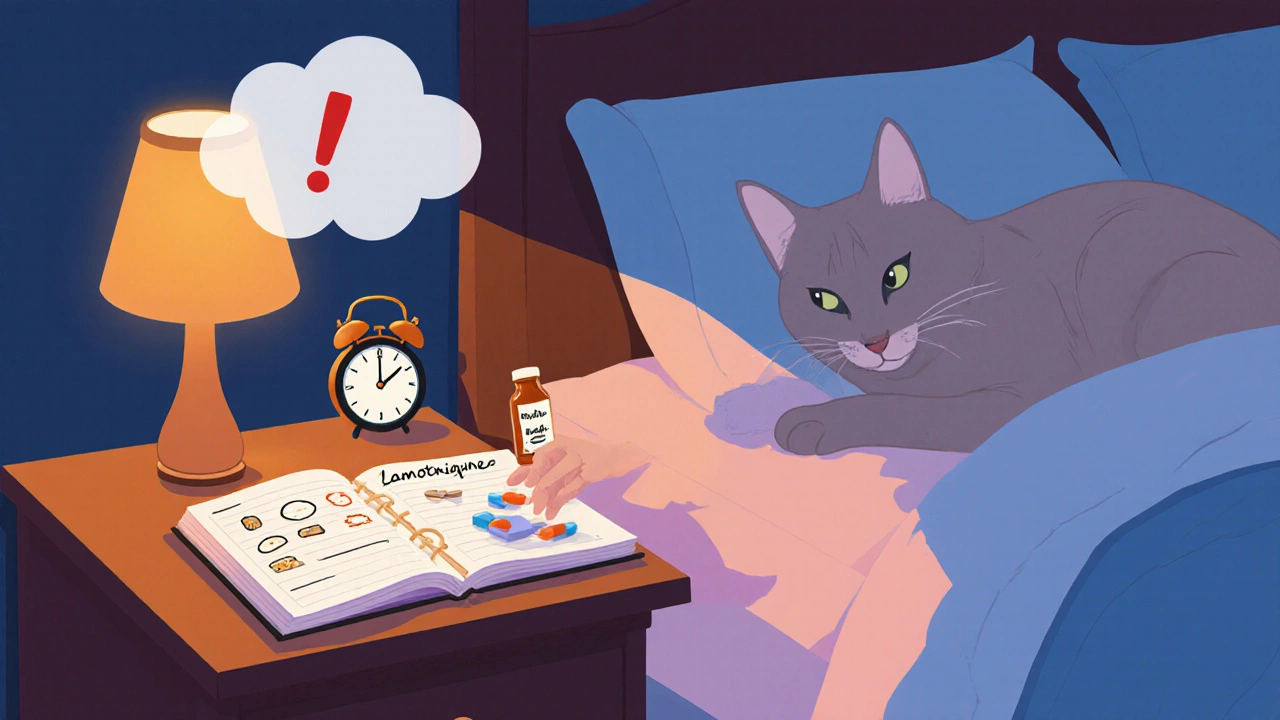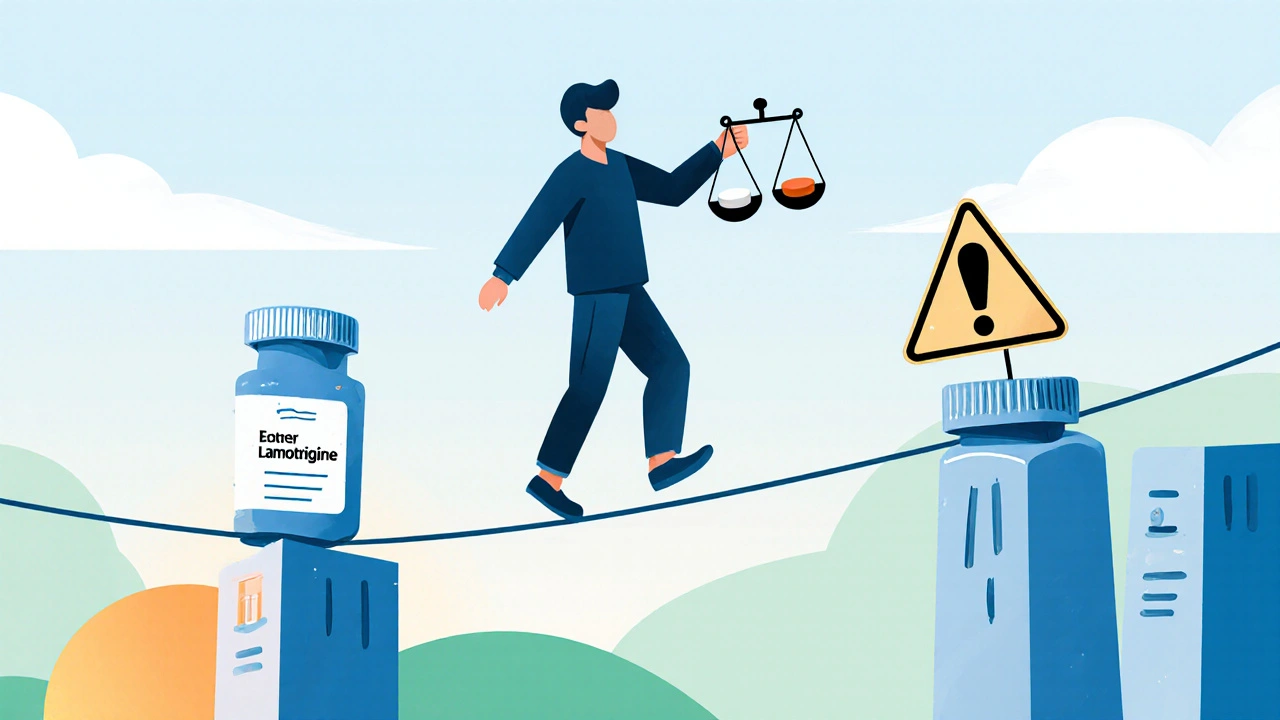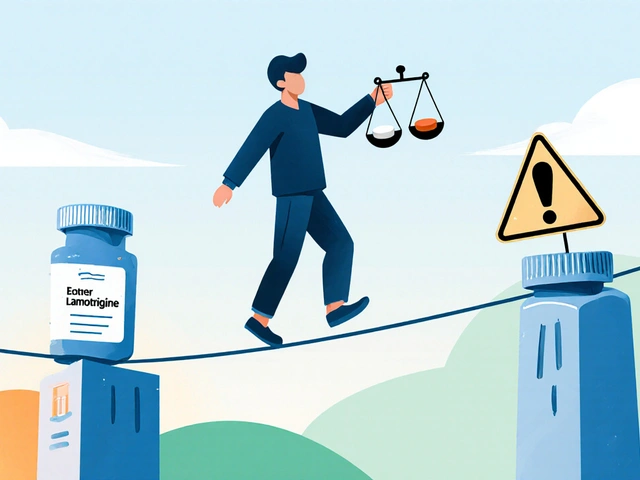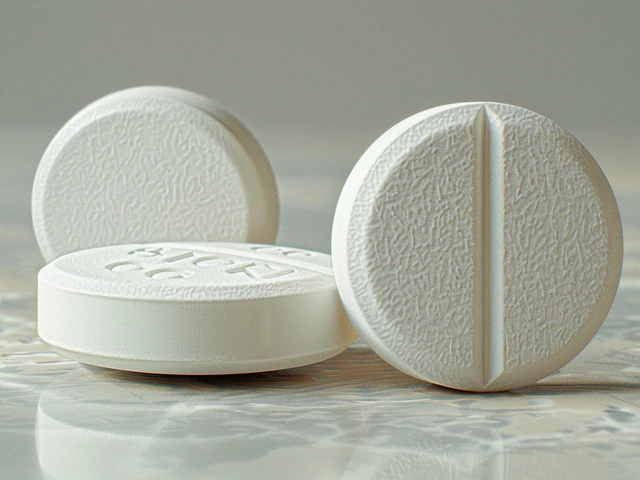Lamotrigine Dosage Calculator
Personalized Dosing Guide
Calculate your individualized starting dose and titration schedule based on your specific medical condition and factors.
Recommended Dosing
Starting Dose
N/A
Titration Schedule
Select your condition to see your personalized titration schedule
Important Warnings
Please select your condition to see relevant warnings
Key Takeaways
- Start low and increase slowly to avoid rash and other side effects.
- Typical maintenance dose for epilepsy is 100‑500 mg daily; for bipolar disorder it’s 200‑400 mg daily.
- Age, liver function, and drug interactions can shift the optimal dose.
- Blood level monitoring is rarely needed but can help in complex cases.
- Always follow a physician‑guided titration schedule and report any skin reactions immediately.
When you hear the word Lamotrigine is a phenyltriazine anticonvulsant approved by the FDA for epilepsy and as a mood stabilizer in bipolar disorder. Its brand name is Lamictal, but many patients take generic versions. Getting the right dose can feel like walking a tightrope-too little may leave seizures or mood swings uncontrolled, too much can trigger a serious rash like Stevens‑Johnson syndrome. This guide walks you through how doctors decide the right amount, what factors you should watch, and practical tips to stay safe.
Why Dose Matters: The Therapeutic Window
Lamotrigine works by stabilizing neuronal voltage‑gated sodium channels, reducing the sudden bursts of electrical activity that cause seizures and mood swings. The drug has a relatively wide therapeutic window, but the margin narrows when you consider individual variability. A lamotrigine dosage that’s perfect for a 70‑kg adult may be too high for a teenager or someone with impaired liver function. Moreover, the risk of a potentially life‑threatening rash climbs sharply if the dose is increased too quickly.
Standard Starting Doses and Titration Schedules
Doctors never start patients at the maintenance dose. They follow a step‑wise titration plan that lets the body adjust. Below are the most common schedules, based on the condition being treated.
| Indication | Starting Dose (mg/day) | Typical Titration Steps | Usual Maintenance Range (mg/day) |
|---|---|---|---|
| Epilepsy (monotherapy) | 25 mg daily | Week 1: 25 mg Week 2: 50 mg Week 3: 100 mg Week 4‑5: 200 mg (if needed) |
100‑500 |
| Epilepsy (with enzyme‑inducing AEDs) | 50 mg daily | Week 1: 50 mg Week 2: 100 mg Week 3: 200 mg Week 4‑5: 300‑400 mg |
200‑600 |
| Bipolar Disorder | 25 mg every other day (first week) | Week 2: 25 mg daily Week 3: 50 mg daily Week 4: 100 mg daily Week 5‑6: 200 mg daily (target) |
200‑400 |
Notice the slower start for bipolar disorder. The FDA required that schedule because mood‑stabilizing patients are more prone to rash. If you’re also taking enzyme‑inducing drugs like carbamazepine or phenytoin, the dose needs to be higher because those medicines speed up lamotrigine clearance.
Key Factors That Influence the Ideal Dose
Even with the same condition, several personal factors push the dose up or down.
- Age and weight: Children under 12 kg start at 0.5 mg/kg/day. Older adults often need 10‑20 % less because liver metabolism slows.
- Liver function: Since lamotrigine is metabolized by hepatic glucuronidation, patients with moderate to severe hepatic impairment may need a 50 % dose reduction.
- Concurrent medications: Enzyme inducers (carbamazepine, phenytoin, phenobarbital) can cut lamotrigine levels by up to 50 %, demanding higher doses. Enzyme inhibitors (valproic acid) double the level, so the dose is halved.
- Pregnancy: Clearance increases, often requiring a 30‑40 % dose boost. After delivery, the dose should be trimmed back to avoid toxicity.
- Genetic variations: Polymorphisms in UGT1A4 can affect metabolism; a handful of labs now test for this when dosing is tricky.
How to Titrate Safely: Step‑By‑Step
- Get a written schedule from your prescriber. Never guess the next step.
- Take the tablet at the same time each day-usually morning or evening.
- Use a pill cutter or a “sprinkle” formulation if you need half tablets. The sprinkle version can be mixed with applesauce, yogurt, or juice.
- Watch for skin changes: any redness, blister, or itching should prompt an immediate call to your doctor.
- If a rash appears early (within the first 2‑3 weeks), the drug is stopped and never restarted.
- Schedule a follow‑up visit after each titration step. The doctor will check blood pressure, liver enzymes, and ask about side effects.
- If you miss a dose, take it as soon as you remember unless it’s almost time for the next dose-don’t double up.
Signs You’re Underdosed or Overdosed
Even with perfect adherence, you might need a tweak.
| Indicator | Suggests |
|---|---|
| Frequent breakthrough seizures or mood swings | Possible under‑dosing |
| Persistent dizziness, ataxia, or double vision | Potential over‑dose |
| Rash, especially within first 8 weeks | Dangerous reaction-stop immediately |
| Elevated liver enzymes (ALT/AST) on labs | Monitor, may need dose reduction |

Managing Common Side Effects
Most people tolerate lamotrigine well, but a few side effects crop up.
- Dizziness or fatigue: Often fades after 2‑3 weeks. If it lingers, the doctor may lower the dose.
- Nausea or headache: Take with food and stay hydrated.
- Skin rash: Any rash warrants immediate discontinuation. Stevens‑Johnson syndrome, though rare (<0.1 %), is a medical emergency.
- Blurred vision: Report if it worsens; could indicate high plasma levels.
Practical Tips for Everyday Use
- Keep a medication diary: note dose, time, and any side effects.
- Store tablets in a cool, dry place; avoid bathroom humidity.
- If you travel across time zones, adjust the schedule gradually to keep the 12‑hour interval.
- Never share your pills; even identical‑looking tablets can be a different formulation.
- Ask your pharmacist about a liquid or sprinkle formulation if swallowing pills is hard.
Frequently Asked Questions
Can I stop lamotrigine abruptly?
No. Sudden discontinuation can trigger seizure recurrence or mood destabilization. Taper the dose under medical supervision, usually dropping 25‑50 mg every 1‑2 weeks.
Do I need regular blood tests while on lamotrigine?
Therapeutic drug monitoring isn’t routine for most patients, but doctors may check liver enzymes and, in complex cases, plasma lamotrigine levels.
What should I do if I develop a rash?
Stop the medication immediately and contact your healthcare provider. Even a mild rash can precede a serious reaction.
Is it safe to take lamotrigine while pregnant?
Lamotrigine is Category C; it’s considered relatively safe but requires dose adjustments because clearance rises during pregnancy. Discuss a personalized plan with your obstetrician.
Can other meds change my lamotrigine dose?
Yes. Enzyme inducers like carbamazepine can halve lamotrigine levels, while valproic acid can double them. Your doctor will adjust the dose accordingly.
Finding the right lamotrigine dose is a collaborative process. By understanding the titration schedule, watching for warning signs, and sharing any concerns with your prescriber, you can maximize seizure control or mood stability while keeping side effects to a minimum.








Wesley Humble October 20, 2025
Lamotrigine titration is a nuanced process that demands both pharmacological insight and vigilant monitoring. Clinicians typically initiate therapy at 25 mg daily for epilepsy monotherapy, a dose deliberately sub‑therapeutic to mitigate rash risk. The pharmacokinetic profile of lamotrigine is heavily influenced by hepatic glucuronidation pathways, which can be accelerated by enzyme‑inducing antiepileptics such as carbamazepine. Conversely, concomitant valproic acid inhibits metabolism, effectively doubling serum concentrations and necessitating dose reductions. Age‑related hepatic function decline warrants a 10‑20 % decrement in maintenance dosing for geriatric patients. Pediatric dosing follows a weight‑based algorithm of 0.5 mg kg⁻¹ day⁻¹, underscoring the importance of individualized regimens. Pregnant individuals experience up to a 40 % increase in clearance, often requiring a proportional dose escalation to preserve therapeutic exposure. The risk of Stevens‑Johnson syndrome escalates sharply when titration steps are compressed, which is why the FDA mandates a gradual schedule for bipolar disorder. Patients should be provided with a written titration chart and instructed to ingest the medication at a consistent time each day. Any cutaneous eruption, however mild, must prompt immediate cessation of the drug and urgent medical evaluation. Blood level monitoring, although not routinely required, can be valuable in atypical scenarios such as polypharmacy or renal impairment. If a dose is missed, the recommendation is to take it as soon as remembered unless the subsequent dose is imminent, avoiding double‑dosing. Adverse effects like dizziness or fatigue generally abate after a few weeks, but persistent symptoms should trigger a dose reassessment. Clinicians often employ the sprinkle formulation for patients who require fractional dosing, enhancing flexibility. Genetic testing for UGT1A4 variants is emerging as a tool to fine‑tune dosing in refractory cases. Overall, a methodical, patient‑centered approach maximizes efficacy while minimizing potentially life‑threatening complications 😊.
barnabas jacob October 20, 2025
Honestly, the way some folks glide over the titration schedule with “just take it when u feel like” nonsense is borderline irresponsible, lol.
Deja Scott October 20, 2025
The guide does a solid job outlining the pharmacological considerations across diverse populations. It also respects cultural variations in healthcare access, which is essential for equitable treatment.
Natalie Morgan October 21, 2025
Check the schedule daily and note any skin changes immediately
Consistency helps avoid dangerous reactions
Israel Emory October 21, 2025
Listen, the titration protocol is not a suggestion, it is a mandate, and any deviation is unacceptable, especially when a rash could mean life‑threatening outcomes!
Doctors provide written instructions, you follow them precisely, you report side effects promptly, and the healthcare system works as intended!
We must respect the process, we must respect each other's safety, and we must avoid careless shortcuts!
Rajesh Myadam October 21, 2025
I understand that the step‑by‑step plan can feel overwhelming, especially when juggling other medications. Take comfort in knowing that many clinicians adjust doses based on liver function and concomitant drugs, which can simplify things. If you ever feel uncertain, reaching out to your pharmacist or prescriber for clarification can make a big difference. Staying consistent with timing and monitoring for rash are simple yet powerful safeguards.
laura wood October 21, 2025
This summary captures the essential points while honoring patients from varied cultural backgrounds. Providing clear instructions in a language that resonates with each individual promotes adherence and safety.
Kate McKay October 21, 2025
You’ve got this-starting low and moving slowly is the golden rule.
Remember, consistency is key; set a reminder on your phone if it helps.
If you notice any skin changes, act fast and call your doctor.
Your health journey is personal, and you deserve a plan that works for you.
Demetri Huyler October 21, 2025
It is astonishing how some people neglect the rigor of evidence‑based protocols in favor of hasty self‑medication.
Our nation’s medical standards are among the finest, and we should uphold them by adhering to the FDA‑mandated titration schedule without compromise.
Anything less reflects a disregard for the scientific heritage that has propelled our healthcare forward.
JessicaAnn Sutton October 21, 2025
Adherence to the prescribed titration timetable is not merely a recommendation but a moral imperative to safeguard one’s health.
Any deviation that endangers oneself or others constitutes a breach of personal responsibility.
The medical community provides these guidelines based on robust data, and ignoring them undermines the collective trust in our healthcare system.
Therefore, patients must treat the schedule with the seriousness it deserves.
Sebastian Green October 21, 2025
I appreciate the thoroughness of this guide; it makes navigating lamotrigine less daunting.
Quietly following the steps can lead to steady progress and peace of mind.